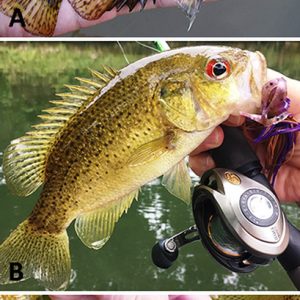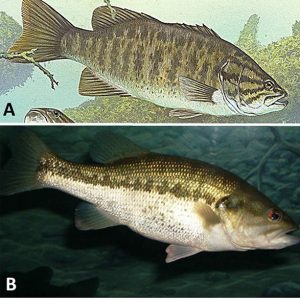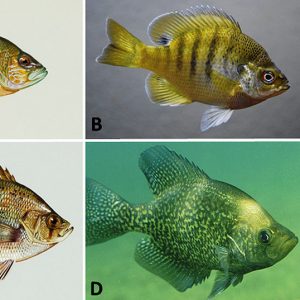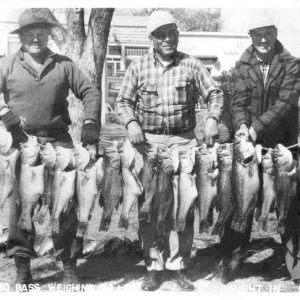calsfoundation@cals.org
Centrarchid Fishes
aka: Sunfishes
The Centrarchidae (sunfishes) are a family of North American native freshwater ray-finned fish belonging to the order Perciformes. There are eight genera and thirty-eight species in the family, thirty-four of which (eighty-nine percent) are extant. The group includes several game and pan fishes familiar to anglers, including smallmouth and largemouth basses, bluegills (“bream”), and crappies. The eight genera are: Acantharchus (mud sunfish), Ambloplites (rock basses), Archoplites (Sacramento perch), Centrarchus (flier), Enneacanthus (banded sunfishes), Lepomis (sunfishes), Micropterus (black basses), and Pomoxis (crappies). In Arkansas, there are five genera and twenty-two species of centrarchids, of which eighteen are native and four are introduced. The latter includes the rock bass (Ambloplites rupestris), redbreast sunfish (Lepomis auritus), redeye bass (Micropterus coosae), and shoal bass (Micropterus cataractae).
Most of the Arkansas game species in the family are found statewide in lakes, streams, and ponds. The rock bass and smallmouth bass (Micropterus dolomieu) are restricted primarily to clear, free-flowing mountainous streams. Both of these fish have also adapted to a few of the large man-made reservoirs of the state in the Ozarks. Many sunfishes are highly valued in sport fishery, and some have been introduced in many areas outside their native North American ranges, often becoming invasive species. While popularly caught by fishing enthusiasts and certainly edible and tasty, centrarchids are not commercially marketed as a food fish.
The relationships of centrarchids to other perciform fish families are not known. The earliest fossils of Centrarchidae first appear in the late Eocene and were quite diverse in Miocene deposits from Montana and South Dakota. Two extinct genera, Boreocentrarchus and Plioplarchus belong to the subfamily Centrarchinae, because these species possess more than three anal fin spines.
The native range of Centrarchidae is confined within North America, ranging across most of the United States and northward to southern Canada. This northern edge of the native range is heavily restricted by temperature due to: (1) reduced foraging ability, (2) reduced growth in cold weather, and (3) subsequent starvation in winter months. As a result, distribution and their ranges in any geographic locale in which they occur will be restricted by bitter temperatures. However, at least eighteen species of centrarchids can also be found worldwide due to intentional introductions within multiple continents including Africa, Asia, Europe, and South America. This spread is mostly due to the high popularity of the family (especially Micropterus spp.) as freshwater gamefish that are frequently stocked for recreational fishing in much of Europe. Across the earth’s expanse, invasive and introduced centrarchids create a major threat to native species in the regions they have invaded. Indeed, there are many instances of largemouth bass (Micropterus salmoides) severely altering and reducing native fish populations in Italy, South Africa, Japan, and Madagascar, and even causing the local extinction of many species of killifishes of the family Cyprinodontidae within the waterbodies they have invaded in Mexico.
Members of the family are differentiated by having a deep laterally compressed body shape covered with ctenoid (rough-edged) scales (except in Acantharcus), thoracic pelvic fins, three (rarely two or four) to eight anal spines, two (fused or broadly connected) dorsal fins (a spinous first dorsal and a rayed second dorsal), and usually six (sometimes seven) branchiostegal rays. The number of dorsal spines among species varies from six to thirteen. All species in the genera Micropterus and Lepomis have three anal spines, which distinguishes them from the other genera in the family. The lateral line is complete in all except the bantam sunfish (Lepomis symmetricus). Many species have bright yellow, orange, or red colors on their breast and belly, particularly among male Lepomis spp. during the breeding season. Most centrarchids can be separated into two main groups based on the two most common genera (Micropterus and Lepomis). Species in the genera Lepomis are characterized by a deep or more round body shape, smaller mouths, and the ability to obtain food through suction feeding. Species in the genera Micropterus are defined by a more streamlined body shape, larger mouths, and the consumption of prey primarily by ram feeding methods.
Body size varies greatly within the family, with the shortest being the black-banded sunfish (Enneacanthus chaetodon) of the eastern Coastal Plain region at 8 cm (3.1 in.) in length, while the longest, the largemouth bass (M. salmoides), is reported to reach almost 1 m (3.3 ft.) in some large cases. In Arkansas, the rod-and-reel record M. salmoides caught at Mallard Lake (Mississippi County) in 1976 weighed in at 7.4 kg (16 lbs., 4 oz.).
Centrarchids are generally sedentary fish that prefer clear, warm, and slower-moving water, and are commonly found in habitats such as low- to medium-flow streams and rivers, lakes, ponds, and swamps. They also prefer to inhabit areas with aquatic vegetation to help avoid predation. Only the endangered Sacramento perch (Archoplites interruptus), native to the Sacramento–San Joaquin Basin of California, can survive in habitats with unusually high alkalinity, salinity, and temperatures. Centrarchids can be found in various locations within the water column, and their exact preference is species specific. For example, bluegill (Lepomis macrochirus) mainly inhabit the deeper littoral zones, while green sunfish (Lepomis cyanellus) prefer habitats near the shoreline and shallower areas.
Centrarchids’ diet is generally decided by sight and is variable depending on the species, but it generally consists of moving macro-invertebrates (e.g., insects, snails, and crayfish) and other fishes (minnows and shiners) found in their habitat. The smaller suction/sight feeders (e.g., Lepomis spp.) generally actively forage off the bottom of their habitat or by lying in wait and making a sudden lunge at the surface or midwater, while the larger top-level predators (e.g., Micropterus spp.) generally ambush prey in the limnetic zone (more open areas).
Adult sunfishes are territorial or occur in small aggregations, and they are often associated with a particular favorite microhabitat such as a submerged stump or tree, vegetation, rocks, or an overhanging bank. However, the crappies (Pomoxis spp.) may occur in large aggregations, especially just prior to spawning.
Centrarchids generally spawn in the spring or early summer, and juveniles emerge in the late spring to early summer. All species within Centrarchidae, except for those in the genus Micropterus, develop an intense coloration in both males and females (although much less defined in females) during the breeding season. The process of courtship and reproduction is nearly identical for all species in the family, which is a major reason for the high levels of hybridization within Centrarchidae. With that said, there are some mechanisms in place to avert hybridization, such as intricate morphology of the operculum in Lepomis, which assists in recognition of conspecific mates.
To commence reproduction, all males (except Archoplites) dig a deep circular depression in the substrate using sweeping caudal fins to construct a nest, which they will aggressively defend from intruding males. Males and females then undergo ritualized courtship dancing before the female deposits her eggs into the male’s nest. Multiple females may deposit eggs over a period ranging from about twenty minutes to several hours in a single nest. Larger males usually attract more mates and also take superior care of their offspring. Two or more females may spawn within the nest of a single male. Male parental care includes nest building, nest guarding, guarding of eggs and fry, and nest fanning (aerating eggs). Males unsuccessful at courtship may exhibit a rogue strategy whereby they sneak fertilizations of female’s eggs by various behavioral techniques. This is commonly observed with sub-adult or smaller males in the genus Lepomis. Predaceous fish trying to steal eggs for food are vigorously driven out by the male if they attempt to enter the nest. Because spawning habitat and behavior often coincides, sunfishes (primarily members of the genus Lepomis) hybridize quite frequently. The green sunfish is an especially arbitrary and promiscuous spawner.
The ability to adapt to cold temperatures at the edge of the sunfish range varies widely within the family. Largemouth bass have no cold acclimation ability as seen through the strict maintenance of the northern boundary of the species range. Other species like smallmouth bass and green sunfish have demonstrated signs of minor cold-water adaptation and have even undergone slight range expansions into colder habitats.
If global warming and the resultant air temperatures continue to increase in the next 50–100 years as predicted, centrarchids and other warm-water-adapted species will likely experience range expansions northward and experience an overall increase in available habitat. However, this range expansion can have grave consequences for other freshwater fishes, as many centrarchids are dominant top predators that have the ability to severely alter the community structure of non-native ecosystems and drive the extinction of other native predators.
The eighteen native centrarchids of Arkansas include the following: shadow bass (Ambloplites ariommus), Ozark bass (A. constellatus), flier (Centrarchus macropterus), L. auritus, L. cyanellus, warmouth (L. gulosus), orangespotted sunfish (L. humilis), L. macrochirus, dollar sunfish (L. marginatus), longear sunfish (L. megalotis), redear sunfish (L. microlophus), spotted sunfish (L. miniatus), L. symmetricus, M. dolomieu, spotted bass (M. punctulatus), M. salmoides, white crappie (Pomoxis annularis), and black crappie (P. nigromaculatus).
There is a wide suite of parasites commonly reported from centrarchids. In Arkansas, several acanthocephalan parasites have been reported from centrarchid fishes, including those from Ozark bass from the Little Red River (Van Buren County) and dollar sunfish from Beard Lake (Hempstead County). Leeches have been reported from white crappie from the Ouachita River (Dallas County).
For additional information:
Alfermann, Ted Joseph. “Centrarchid Assemblages in Oxbox Lakes of the Mississippi Alluvial Valley with Perspectives for Fisheries Management.” MS thesis, Mississippi State University, 2011. Online at https://scholarsjunction.msstate.edu/td/980/ (accessed June 14, 2022).
Berra, Tim. Freshwater Fish Distribution. Chicago: University of Chicago Press, 2007.
Blumer, Lawrence S. “A Bibliography and Categorization of Bony Fishes Exhibiting Parental Care.” Zoological Journal of the Linnean Society 75 (1982): 1–22.
Carpenter, Stephen R., Stuart G. Fisher, Nancy B. Grimm, and James F. Kitchell. “Global Change and Freshwater Ecosystems.” Annual Review of Ecology and Systematics 23 (1992): 119–139.
Carroll, Andrew M., Peter C. Wainwright, Stephen H. Huskey, David C. Collar, and Ralph G. Turingan. “Morphology Predicts Suction Feeding Performance in Centrarchid Fishes.” Journal of Experimental Biology 207 (2004): 3873–3881.
Cooke, S. J., and D. P. Philipp. Centrarchid Fishes: Diversity, Biology, and Conservation. Hoboken, NJ: Blackwell Publishing Ltd., 2009.
Douglas, Neil H. The Fishes of Louisiana. Baton Rouge: Claitor’s Publishing Division, 1974.
Etnier, David A., and Wayne C. Starnes. The Fishes of Tennessee. Knoxville: University of Tennessee Press, 1993.
Gross, Mart R., and Eric L. Charnov. “Alternative Male Life Histories in Bluegill Sunfish.” Proceedings of the National Academy of Sciences 77 (1980): 6937–6940.
Hoffman, Glenn L. Parasites of North American Freshwater Fishes. Second Edition. Berkeley: University of California Press, 2009.
Jennings, Martin J., David P. Philipp, and W. L. Montgomery. “Alternative Mating Tactics in Sunfishes (Centrarchidae): A Mechanism for Hybridization?” Copeia 2002 (2002): 1102–1105.
Lyons, J., J. S. Stewart, and M. Mitro. “Predicted Effects of Climate Warming on the Distribution of 50 Stream Fishes in Wisconsin, U.S.A.” Journal of Fish Biology 77 (2010): 1867–1898.
McAllister, Chris T., Stephanie F Barclay, and Henry W. Robison. “New Geographic Distribution Records for the Flier, Centrarchus macropterus (Perciformes: Centrarchidae), from Southwestern Arkansas.” Journal of the Arkansas Academy of Science 58 (2004): 131‒132. Online at https://scholarworks.uark.edu/cgi/viewcontent.cgi?article=1583&context=jaas (accessed January 10, 2020).
McAllister, Chris T., Michael A. Barger, and Henry W. Robison. “Additional Records of Acanthocephalan Parasites from Arkansas Fishes, with New Records from Missouri Fishes.” Journal of the Arkansas Academy of Science 72 (2018): 94‒98. Online at https://scholarworks.uark.edu/cgi/viewcontent.cgi?article=3318&context=jaas (accessed January 10, 2020).
McAllister, Chris T., William E. Moser, and Donald J. Klemm. “Actinobdella inequiannulata (Annelida: Hirudinida: Rhynchobdellida: Glossiphonidae) from White Crappie, Pomoxis annularis (Perciformes: Centrarchidae), in Arkansas, U.S.A.” Comparative Parasitology 78 (2011): 392–394.
McAllister, Chris T., Renn Tumlison, and Henry W. Robison. “The Bantam Sunfish, Lepomis symmetricus (Perciformes: Centrarchidae), in Arkansas: New Geographic Distribution Records.” Texas Journal of Science 60 (2008): 23‒32.
Mettee, M. F., P. E. O’Neil, and J. M. Pierson. Fishes of Alabama and the Mobile Basin. Birmingham, AL: Oxmoor House, 1996.
Miller, Rudolph J., and Henry W. Robison. Fishes of Oklahoma. Norman: University of Oklahoma Press, 2004.
Near, Thomas J., D. I. Bolnick, and P. C. Wainwright. “Fossil Calibrations and Molecular Divergence Time Estimates in Centrarchid Fishes (Teleostei: Centrarchidae).” Evolution 59 (2005): 1768–1782.
Near, Thomas J., Todd W. Kassler, Jeffrey B. Koppelman, Casey B. Dillman, David P. Philipp, and G. Orti. “Speciation in North American Black Basses, Micropterus (Actinopterygii: Centrarchidae).” Evolution 57 (2003): 1610–1621.
Near, Thomas J., and J. B. Koppelman, Species Diversity, Phylogeny and Phylogeography of Centrarchidae. Hoboken, NJ: Wiley-Blackwell, 2009.
Page, Larry M., and Brooks M. Burr. Peterson Field Guide to Freshwater Fishes of North America North of Mexico. Second Ed. Boston: Houghton Mifflin Harcourt, 2011.
Pflieger, William L. The Fishes of Missouri. Jefferson City: Missouri Department of Conservation, 1997.
Robison, Henry W., and Thomas M. Buchanan. Fishes of Arkansas. 2nd ed. Fayetteville: University of Arkansas Press, 2020.
Roe, Kevin J., Phillip M. Harris, and Richard L. Mayden. “Phylogenetic Relationships of the Genera of North American Sunfishes and Basses (Percoidei: Centrarchidae) as Evidenced by the Mitochondrial Cytochrome b Gene.” Copeia 2002 (2002): 897–905.
Rypel, Andrew L. “The Cold-Water Connection: Bergmann’s Rule in North American Freshwater Fishes.” American Naturalist 183 (2014): 147–156.
Shuter, B. J., A. G. Finstad, I. P. Helland, I. Zweimüller, and F. Hölker. “The Role of Winter Phenology in Shaping the Ecology of Freshwater Fish and Their Sensitivities to Climate Change.” Aquatic Sciences 74 (2012): 637–657.
Smith, Andrew J., Nathan Nelson-Maney, Kevin J. Parsons, W. James Cooper, and R. Craig Albertson. “Body Shape Evolution in Sunfishes: Divergent Paths to Accelerated Rates of Speciation in the Centrarchidae.” Evolutionary Biology 42 (2015): 283–295.
Tschantz, Deidra R., Elizabeth L. Crockett, Peter H. Niewiarowski, and Richard L. Londraville. “Cold Acclimation Strategy Is Highly Variable among the Sunfishes (Centrarchidae).” Physiological and Biochemical Zoology 75 (2002): 544–556.
Werner, Earl E., and Donald J. Hall. “Competition and Habitat Shift in Two Sunfishes (Centrarchidae).” Ecology 58 (1977): 869–876.
Chris T. McAllister
Eastern Oklahoma State College
 Science and Technology
Science and Technology Arkansas Ambloplites
Arkansas Ambloplites  Arkansas Basses
Arkansas Basses  Arkansas Sunfishes
Arkansas Sunfishes  Fishermen
Fishermen 



Comments
No comments on this entry yet.